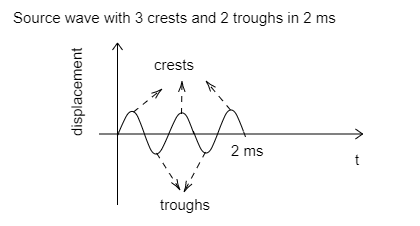
Find the frequency of the wave that produces 3 crests and 2 troughs in 2 ms.
A. 1250 Hz
B. 500 Hz
C. 800 Hz
D. 750 Hz
Answer
219.6k+ views
Hint: The period of a wave refers to the time taken to complete one cycle. One cycle corresponds to one crest and one trough i.e., one wavelength. The frequency of the wave will be the reciprocal of the wave period.
Formula Used:
1. Period of a wave is given by, $T = \dfrac{t}{n}$ where $t$ is the time taken to complete $n$ number of cycles.
2. The frequency of a wave is given by, $f = \dfrac{1}{T}$ where $T$ is the period of the wave.
Complete step by step answer:
Step 1: Sketch a rough figure of the source wave and list its features.

The number of crests produced is 3 and the number of troughs produced is 2 in a time of 2 ms.
One crest and one trough can be considered to constitute one cycle. Here two crests and two troughs will then constitute two cycles and the remaining crest will constitute a half cycle. So a total of 2.5 cycles are produced in a given time of 2 ms.
Step 2: Calculate the period of the wave.
Period of the source wave is given by, $T = \dfrac{t}{n}$ --------- (1)
where $t$ is the time taken to complete $n$ number of cycles.
Substituting for $t = 2{\text{ms}}$ and $n = 2.5$ in equation (1) we get, $T = \dfrac{{0.002}}{{2.5}}800{\text{s}}$
So, the period of the wave is $T = 800{\text{s}}$ .
Step 3: Find the frequency of the wave using its period.
The frequency of a wave is given by, $f = \dfrac{1}{T}$ --------- (2) where $T$ is the period of the wave.
Substituting for $T = 800{\text{s}}$ in equation (2) we get, $f = \dfrac{1}{{800}} = 1250{\text{Hz}}$
$\therefore $ the frequency of the source wave is $f = 1250{\text{Hz}}$. So, the correct option is A.
Note: Frequency of a wave refers to the number of cycles completed in one second and so will be inversely proportional to the wave period. The unit of the wave period is seconds. So, while substituting the value for $t$ in equation (1) make sure that it is expressed in seconds as well. If not necessary conversion must be done. Here, $t = 2{\text{ms}}$ is converted to $t = 2 \times {10^{ - 3}}{\text{s}} = 0.002{\text{s}}$ and substituted in equation (1).
Formula Used:
1. Period of a wave is given by, $T = \dfrac{t}{n}$ where $t$ is the time taken to complete $n$ number of cycles.
2. The frequency of a wave is given by, $f = \dfrac{1}{T}$ where $T$ is the period of the wave.
Complete step by step answer:
Step 1: Sketch a rough figure of the source wave and list its features.

The number of crests produced is 3 and the number of troughs produced is 2 in a time of 2 ms.
One crest and one trough can be considered to constitute one cycle. Here two crests and two troughs will then constitute two cycles and the remaining crest will constitute a half cycle. So a total of 2.5 cycles are produced in a given time of 2 ms.
Step 2: Calculate the period of the wave.
Period of the source wave is given by, $T = \dfrac{t}{n}$ --------- (1)
where $t$ is the time taken to complete $n$ number of cycles.
Substituting for $t = 2{\text{ms}}$ and $n = 2.5$ in equation (1) we get, $T = \dfrac{{0.002}}{{2.5}}800{\text{s}}$
So, the period of the wave is $T = 800{\text{s}}$ .
Step 3: Find the frequency of the wave using its period.
The frequency of a wave is given by, $f = \dfrac{1}{T}$ --------- (2) where $T$ is the period of the wave.
Substituting for $T = 800{\text{s}}$ in equation (2) we get, $f = \dfrac{1}{{800}} = 1250{\text{Hz}}$
$\therefore $ the frequency of the source wave is $f = 1250{\text{Hz}}$. So, the correct option is A.
Note: Frequency of a wave refers to the number of cycles completed in one second and so will be inversely proportional to the wave period. The unit of the wave period is seconds. So, while substituting the value for $t$ in equation (1) make sure that it is expressed in seconds as well. If not necessary conversion must be done. Here, $t = 2{\text{ms}}$ is converted to $t = 2 \times {10^{ - 3}}{\text{s}} = 0.002{\text{s}}$ and substituted in equation (1).
Recently Updated Pages
Electricity and Magnetism Explained: Key Concepts & Applications

JEE Energetics Important Concepts and Tips for Exam Preparation

JEE Isolation, Preparation and Properties of Non-metals Important Concepts and Tips for Exam Preparation

JEE Main 2021 July 25 Shift 1 Question Paper with Answer Key

JEE Main 2021 July 22 Shift 2 Question Paper with Answer Key

States of Matter Chapter For JEE Main Chemistry

Trending doubts
Understanding Uniform Acceleration in Physics

Understanding Atomic Structure for Beginners

Understanding Centrifugal Force in Physics

JEE Main Marking Scheme 2026- Paper-Wise Marks Distribution and Negative Marking Details

Degree of Dissociation: Meaning, Formula, Calculation & Uses

Understanding Average and RMS Value in Electrical Circuits

Other Pages
NCERT Solutions for Class 11 Physics Chapter 6 System Of Particles And Rotational Motion 2025-26

Understanding Entropy Changes in Different Processes

Common Ion Effect: Concept, Applications, and Problem-Solving

Understanding Excess Pressure Inside a Liquid Drop

NCERT Solutions For Class 11 Physics Chapter 12 Kinetic Theory - 2025-26

Motion In A Plane Class 11 Physics Chapter 3 CBSE Notes - 2025-26




